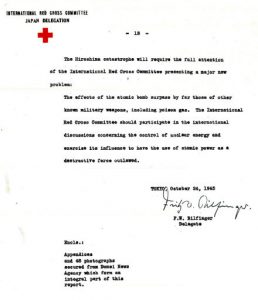Striving to fill voids in Hiroshima, evidence of victims remain 76 years after the atomic bombing—Medical charts in aftermath, Part 5: Red Cross report
Aug. 3, 2021
by Kyosuke Mizukawa and Junji Akechi, Staff Writers
“The effects of the atomic bomb surpass by far those of other known military weapons, including poison gas. The International Red Cross Committee should exercise its influence to have the use of atomic power as a destructive force outlawed.”
The late Fritz Bilfinger (1901–1993), an official of the International Committee of the Red Cross (ICRC) in Japan who came to Hiroshima on August 29, 1945, 23 days after the U.S. military dropped the atomic bomb on the city, summarized the ICRC’s classified report using those words. The report is still archived at the ICRC headquarters in Geneva, Switzerland, along with a telegram that informed the Japan delegation of the terrible situation.
Urging Japan delegation to secure relief items
According to a telegram dated August 30, which read “Inspected two emergency hospitals conditions beyond description. Many victims apparently recovering suddenly suffer fatal relapse due to decomposition of white blood cells and other internal injuries now dying in great numbers.” In this way, Mr. Bilfinger urged the late Marcel Junod, head of the ICRC delegation in Japan, to secure relief items such as medical supplies.
Mr. Bilfinger also drew up the classified report, quoted at the beginning of this article, dated October 24 in which he described the devastation of the city in detail. He attached the clinical records of four men between the ages of 26 and 38 who were transported to a hospital in Osaka after the atomic bombing and died after suffering from high fever and bleeding.
Seventy-six years later, in January 2021, the Treaty on the Prohibition of Nuclear Weapons (TPNW) went into effect. The ICRC played an important role in promoting the treaty. Fasia Teixeria, associate of the ICRC Legal Division, emphasized the importance of the role played by Mr. Bilfinger. The report described the devastation of the city and the suffering of A-bomb survivors who could see no end to their agony due to radiation, and with that played a role in turning people’s attention to the inhumane effects of nuclear weapons and in forming the basis for efforts to ban and abolish nuclear weapons.
Mr. Teixeria believes it is important to continue raising awareness of the inhumanity of nuclear weapons in each country through materials and accounts from Hiroshima and Nagasaki. “It is so that we will never forget our humanitarian and moral obligation to prevent the misery caused by nuclear weapons,” he said.
Medical materials are expected to be further utilized to promote the necessity of prohibiting and abolishing nuclear weapons. Makoto Matsumura, 71, chair of the Hiroshima Prefectural Medical Association, stated emphatically that it was that organization’s responsibility to preserve such records and pass them on to following generations. In 2005, he collected on his own certificates written immediately after the atomic bombing that were found in the city, causing him to deeply consider the struggles of physicians at the time.
Eight organizations, including the prefectural medical association, as well as the Hiroshima Prefectural and City governments have established a team representing Hiroshima in its entirety to make international contributions based on its knowledge regarding medical care for A-bomb survivors in Hiroshima. The organizations hope to conduct surveys of members of the medical association to learn the number of remaining A-bomb materials related to the atomic bombing, keeping in mind that they are in danger of being dispersed or lost over time. Moreover, the group hopes that the preservation activities will reach all the way to the framework of the Hiroshima International Council for Health Care of the Radiation-exposed (HICARE).
Government has responsibility to support preservation and utilization of medical records
The atomic bomb used by the U.S. military on Hiroshima 76 years ago took the lives of at least 200 physicians responsible for treating citizens. In the midst of the confusion at that time, physicians who survived in the suburbs and other areas and researchers who came from outside the prefecture left behind medical and other records. While trying to find a balance with the protection of personal information, there seems to be no reason to not fully utilize the medical records created after the atomic bombing that clearly describe the last moments, wounds, and symptoms that perhaps even family did not understand.
Only a small number of valuable records remain outside the prefecture and overseas. To preserve and utilize the materials, the cooperation of not only related organizations in and outside the prefecture but also support from the Japanese national government are indispensable. The A-bombed nation of Japan has the responsibility to archive and convey evidence to the world of the inhumanity of nuclear weapons.
The International Committee of the Red Cross (ICRC)
The ICRC was established in 1863. The organization has been providing humanitarian aid and other assistance in conflict zones around the world based on its stance of neutrality for more than 150 years. Its activities are designed to ensure adherence to international humanitarian law, which prohibits indiscriminate attacks and the use of weapons that cause unnecessary suffering. The group’s headquarters are located in Geneva, Switzerland. In September 1945, Dr. Marcel Junod, then head of the ICRC delegation in Japan, is known to have brought about 15 tons of medicine to Hiroshima with which he treated A-bomb survivors.
This concludes the series of “Striving to fill voids in Hiroshima 76 years after atomic bombing―Medical charts in aftermath.”
(Originally published on August 3, 2021)
Preliminary report on inhumanity of atomic bombing used as basis for banning nuclear weapons
“The effects of the atomic bomb surpass by far those of other known military weapons, including poison gas. The International Red Cross Committee should exercise its influence to have the use of atomic power as a destructive force outlawed.”
The late Fritz Bilfinger (1901–1993), an official of the International Committee of the Red Cross (ICRC) in Japan who came to Hiroshima on August 29, 1945, 23 days after the U.S. military dropped the atomic bomb on the city, summarized the ICRC’s classified report using those words. The report is still archived at the ICRC headquarters in Geneva, Switzerland, along with a telegram that informed the Japan delegation of the terrible situation.
Urging Japan delegation to secure relief items
According to a telegram dated August 30, which read “Inspected two emergency hospitals conditions beyond description. Many victims apparently recovering suddenly suffer fatal relapse due to decomposition of white blood cells and other internal injuries now dying in great numbers.” In this way, Mr. Bilfinger urged the late Marcel Junod, head of the ICRC delegation in Japan, to secure relief items such as medical supplies.
Mr. Bilfinger also drew up the classified report, quoted at the beginning of this article, dated October 24 in which he described the devastation of the city in detail. He attached the clinical records of four men between the ages of 26 and 38 who were transported to a hospital in Osaka after the atomic bombing and died after suffering from high fever and bleeding.
Seventy-six years later, in January 2021, the Treaty on the Prohibition of Nuclear Weapons (TPNW) went into effect. The ICRC played an important role in promoting the treaty. Fasia Teixeria, associate of the ICRC Legal Division, emphasized the importance of the role played by Mr. Bilfinger. The report described the devastation of the city and the suffering of A-bomb survivors who could see no end to their agony due to radiation, and with that played a role in turning people’s attention to the inhumane effects of nuclear weapons and in forming the basis for efforts to ban and abolish nuclear weapons.
Mr. Teixeria believes it is important to continue raising awareness of the inhumanity of nuclear weapons in each country through materials and accounts from Hiroshima and Nagasaki. “It is so that we will never forget our humanitarian and moral obligation to prevent the misery caused by nuclear weapons,” he said.
Medical materials are expected to be further utilized to promote the necessity of prohibiting and abolishing nuclear weapons. Makoto Matsumura, 71, chair of the Hiroshima Prefectural Medical Association, stated emphatically that it was that organization’s responsibility to preserve such records and pass them on to following generations. In 2005, he collected on his own certificates written immediately after the atomic bombing that were found in the city, causing him to deeply consider the struggles of physicians at the time.
Eight organizations, including the prefectural medical association, as well as the Hiroshima Prefectural and City governments have established a team representing Hiroshima in its entirety to make international contributions based on its knowledge regarding medical care for A-bomb survivors in Hiroshima. The organizations hope to conduct surveys of members of the medical association to learn the number of remaining A-bomb materials related to the atomic bombing, keeping in mind that they are in danger of being dispersed or lost over time. Moreover, the group hopes that the preservation activities will reach all the way to the framework of the Hiroshima International Council for Health Care of the Radiation-exposed (HICARE).
Government has responsibility to support preservation and utilization of medical records
The atomic bomb used by the U.S. military on Hiroshima 76 years ago took the lives of at least 200 physicians responsible for treating citizens. In the midst of the confusion at that time, physicians who survived in the suburbs and other areas and researchers who came from outside the prefecture left behind medical and other records. While trying to find a balance with the protection of personal information, there seems to be no reason to not fully utilize the medical records created after the atomic bombing that clearly describe the last moments, wounds, and symptoms that perhaps even family did not understand.
Only a small number of valuable records remain outside the prefecture and overseas. To preserve and utilize the materials, the cooperation of not only related organizations in and outside the prefecture but also support from the Japanese national government are indispensable. The A-bombed nation of Japan has the responsibility to archive and convey evidence to the world of the inhumanity of nuclear weapons.
Keywords
The International Committee of the Red Cross (ICRC)
The ICRC was established in 1863. The organization has been providing humanitarian aid and other assistance in conflict zones around the world based on its stance of neutrality for more than 150 years. Its activities are designed to ensure adherence to international humanitarian law, which prohibits indiscriminate attacks and the use of weapons that cause unnecessary suffering. The group’s headquarters are located in Geneva, Switzerland. In September 1945, Dr. Marcel Junod, then head of the ICRC delegation in Japan, is known to have brought about 15 tons of medicine to Hiroshima with which he treated A-bomb survivors.
This concludes the series of “Striving to fill voids in Hiroshima 76 years after atomic bombing―Medical charts in aftermath.”
(Originally published on August 3, 2021)









